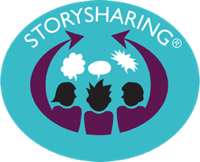What is Storysharing®
Storysharing® enables children and adults with communication difficulties to remember and tell their stories of everyday life. The focus is on what they CAN do to contribute. It’s based on the way we all share experiences in conversation, and on research studies
Why are stories important?
Research shows that personal stories are how we make sense of what happens in our lives – they are central to our sense of who we are.
- 65-80% of communications relate to a personal experience
- We make and keep friends through sharing stories
- Telling our stories can lead to social change - it’s empowering
- The ability to tell a story helps with communication, language and educational achievement
- Sharing stories helps to build recovery and resilience after difficult times
- Telling stories is creative and fun
Who is it for?
People of all ages with learning and communication difficulties including:
- Mild and moderate learning disabilities
- Severe learning disabilities
- Profound and multiple learning disabilities
- Hearing impairments, visual impairments and multisensory impairments
- Developmental language difficulties
- Autistic Spectrum Disorders
- ADHD
- Social and emotional difficulties
- Those finding it hard to express themselves in the dominant language of a culture (English in the UK)
- Anyone facing stigma and social isolation
What are the barriers to overcome?
Research shows that many people with severe communication difficulties have stories told ABOUT them, or FOR them, but they don’t get to tell stories WITH others, or independently. You might think this is because they find it hard to talk…well obviously that’s an issue. But in fact our work shows that what prevents them sharing their stories are social factors like….low expectations….not making time … not knowing how to support a person to remember and share a story… organisations not valuing personal stories… fear of stories that are thought to be sad or upsetting…most of all, because there is so much routine, there seem to be no stories to tell.
The good news is that these are things we can change.
How can Storysharing® be used?
Storysharing is a highly flexible and versatile communication tool that can be used in a wide range of situations. There’s no expensive technology involved - the best resource is you.
Examples of ways to use Storysharing in projects and training:
- In schools - To support new pupils, for transitions and change, to enable pupil voice
- Peer mentoring and support - School councils, assemblies, and intergenerational projects
- Making friends and building empathy - Storysharing increases peer interaction and supports better listening. It’s fun too.
- Review and transition meetings - Finding a way to contribute effectively: stories about the things that matter can influence choices about the future.
- Tenant meetings - Supporting choice and decisions by remembering and sharing.
- Self advocacy in meetings - ‘Having a voice. ’Real life stories help professionals to understand real life issues.
- Building personal histories to share with others - Remembering the past and putting it in perspective.
What are the benefits of Storysharing?
Independent research and our own reports show that Storysharing supports:
- Communication
- Making friends - increased interaction between peers
- Self-advocacy
- Making decisions
- Well being
- Confidence
- Having a voice in decision making, such as transitions and reviews
- Remembering
- Joining in
- Listening
- Staff knowledge and insight
We already use social stories and sensory stories. What’s the difference?
Storysharing® is distinctive because it centres on face to face telling to others; telling together; active listening, and on particular or one off events with emotional significance. This involves “episodic memory”.
Social stories, by contrast, are about what usually happens - they call on “semantic or knowledge memory”. For example, what happens when I go swimming is a social story that helps a person predict what is coming. What happened when I fell in the pool is a one off story to share that is funny, or exciting, or scary, or shows how I was courageous.
Sensory stories are made into books or storyboards to read together. Usually these are fictional stories.
Of course we often do make personal stories into storybooks as well.
All of these approaches are useful, and they complement each other.
How do I start?
Anyone can use Storysharing® - once you understand the basic techniques: families, teachers, classroom assistants, health and social care staff.
The principles are very simple, but to use it really effectively across a range of different contexts and with people of different abilities, training is invaluable. See our Training page for a range of accessible options.
The Big Book of Storysharing (Grove, 2014) which describes the early practice is freely available. https://www.booksetc.co.uk/books/view/-9781909301405
Images
3 Steps to Storysharing pdf image and guide
The Big Book of Storysharing (from website)
